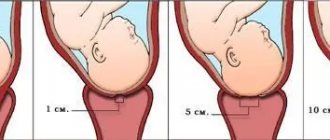Figure: Hydatidiform mole.
Figure: Hydatidiform mole. In the center are the remains of the egg cavity.
Each of the bubbles microscopically represents a degenerated villus; on the surface of the vesicles, randomly overgrown syncytial cells lie in several layers, under them there is a layer of regenerative cells (Langhans), and in the center there is edematous embryonic mesenchymal tissue. In some cases, the altered villi grow into the decidual tissue, myometrium, and even the serous covering of the uterus. In these cases, a destructive hydatidiform mole (mola hydatidosa destruens) occurs. With this form of hydatidiform mole, dangerous intra-abdominal and external bleeding is possible; the tumor itself becomes malignant. Often hydatidiform mole is accompanied by the formation of rapidly growing bilateral ovarian tumors, reaching sizes from a chicken egg to a fist. These are luteal cysts (corpus luteum cysts), lined on the inside with a layer of luteal cells. A characteristic feature of these cysts is that after the uterus has emptied, they undergo reverse development and disappear after 2-4 weeks.
Picture: Destructive hydatidiform mole.
The etiology of hydatidiform mole is not clear; a possible cause of this disease is neuroendocrine disorders. With hydatidiform mole, the amount of chorionic gonadotropin in the urine increases sharply, exceeding 50,000 units in 1 liter of urine (in normal pregnancy - 5,000-10,000 units). Therefore, quantitative analysis of chorionic gonadotropin can serve as the basis for early biological diagnosis of hydatidiform mole. The pathogenesis of the disease is not well understood. It has been established that the syncytium and Langhans layer are affected first, while the stroma undergoes degenerative changes secondarily. Clinic of hydatidiform mole - bleeding of varying strength and duration; they usually begin in the 3rd month of pregnancy or later and are repeated several times. The diagnosis of the disease is made by the discrepancy between the gestational age and the size of the uterus, which increases extremely quickly in volume. Noteworthy is the doughy consistency of the uterus and the absence of fetal heart sounds and movements. The diagnosis is made easier if mole bubbles come out along with the blood. With hydatidiform mole, symptoms of toxicosis often develop: vomiting, swelling in the legs, albuminuria. In doubtful cases, the Tsondek-Aschheim reaction quickly clarifies the diagnosis, being positive even with a 10-fold dilution of urine. The prognosis for hydatidiform mole is always questionable, not only because of possible complications during its birth, but also because in 10-15% of cases there is a transition from hydatidiform mole to a malignant tumor - chorionepithelioma. Therapy for hydatidiform mole consists of trying to induce expulsion with the help of oxytocic substances. Quinine and pituitrin are prescribed in combination with glucose and calcium chloride. In cases of severe bleeding, active intervention is necessary - dilation of the cervix and removal of the mole with fingers or a large curette. Curettage with a curette is dangerous due to the possibility of perforation of the thinned walls of the uterus. Sometimes it is necessary to empty the uterus in two steps: first, the main masses of the mole are removed with a forceps or fingers, and after a few days, when the uterus contracts, curettage is performed. Chorionepithelioma, as stated, can develop from a hydatidiform mole. But it can also form after normal childbirth and uncomplicated miscarriage, and early. The time interval between the end of pregnancy (childbirth, abortion, hydatidiform mole) and the beginning of the development of chorionepithelioma is the “latent period” of the disease, lasting from several days to 3 years. Chorionepithelioma is a malignant tumor that develops from the chorionic epithelium. Its significant difference from hydatidiform mole is as follows: with hydatidiform mole, syncytium, Langhans cells and mesodermal connective tissue undergo proliferation; with chorionepithelioma, the mesodermal stroma is absent, only epithelial elements, mainly syncytium, grow. The development of chorionepithelioma is characterized by abnormal uterine bleeding, the patient loses weight, the temperature rises, and sometimes cough, chest pain, and hemoptysis appear, which indicates metastases in the lungs. In addition to the latter, chorionepithelioma is characterized by metastases in the vaginal walls, reaching a large size.
Figure: Chorionepithelioma of the uterus with metastases to the vagina.
These metastases are formed due to the retrograde introduction of cellular elements of the villi along the paravaginal veins. In the uterus, primarily on the placental site, softish nodes the size of a walnut to an egg of a crimson-violet color with signs of decay are found. In the ovaries, the same cysts (luteal) are often detected as with hydatidiform mole.
Figure: Luteal cysts in chorionepithelioma.
Chorionepithelioma (chorioniccarcinoma) is a malignant form of trophoblastic disease, occurring in up to 8% of cases per 1,000 births. The neoplasm develops as a result of malignant degeneration of epithelial cells of the chorion (villous membrane, placenta in the first trimester of pregnancy). Most often, the formation of chorionepithelioma is preceded by a hydatidiform mole (molar pregnancy) - almost half of the cases, abortion - a quarter of all cases, childbirth - 20% of cases, ectopic pregnancy - about 3% of cases.
Description
The reasons for the formation of chorionepithelioma have not yet been well studied. But the prerequisites for the development of this disease are:
- viral transformation of the trophoblast - the wall of the vesicle, which subsequently gives rise to the outer layer of the membranes of the embryo;
- exposure to pregnancy hormones: estrogens, progesterone, hCG;
- metabolic disorder;
- immune system imbalance;
- increasing the functional activity of hyaluronidase, a special protein that can increase tissue permeability;
- protein deficiency.
Leading clinics in Israel
Chorionepithelioma most often forms at the site of nidation (implantation) of the fertilized egg in the upper half of the uterine body or in one of its corners. Sometimes such a tumor occurs in the vagina, on the cervix, fallopian tube, and ovaries. Tumor nodes can be either single or multiple. In cross section, they consist of spongy dark red tissue with a soft consistency, reminiscent of an afterbirth.
Such tumors do not have stroma or their own vessels. Cancer cells begin to grow into blood vessels, as a result of which the inner layer covering the walls of blood vessels (endothelium) dies and affects them. Necrosis develops on the walls of blood vessels and they rupture, causing bleeding and thrombosis.
Chorionepithelioma occurs more often in women with repeated pregnancies. The latent (hidden) period is the time from the last birth to the formation of a tumor; it can last from a month to 15-20 years. Women from 18 to 55 years old get sick. The neoplasm spreads mainly through blood vessels intravasally and extravasally. With intravasal growth, a malignant neoplasm destroys the walls of blood vessels and affects surrounding tissues.
Chorionepithelioma metastasizes to the vagina, liver, lungs, brain and other organs. It is characterized by diverse and early metastases, which gives rise to the name “metastasis disease”. Ectopic chorionepithelioma occurs in the lungs, stomach, liver, mediastinum and other organs. Chorionepithelioma can also occur in men with localization in the testicle. In such cases, it metastasizes to the lungs, peritoneal lymph nodes, and liver.
During pregnancy, women experience another disease of the chorion – chorioamnionitis. This is an infectious-inflammatory process of the fetal membranes (walls of the amniotic sac) and infection of the amniotic fluid. Due to the close anatomical connection between the membranes and the endometrium (uterine lining), chorioamnionitis almost always develops into endometritis - inflammation of the inner layer of the uterus.
Causes
To date, the exact factors provoking the disease have not been established. There are only some assumptions according to which chorionepithelioma may begin to develop against the background of a complete bladder pump. This phenomenon is diagnosed in approximately 20 percent of cases of all malignant tumors.
In addition, the cause of the pathology can be spontaneous miscarriage, which occurs in 25 percent of cases. During normal pregnancy, the disease is also diagnosed in 25% of cases.
Scientists were also able to identify a connection between the appearance of the pathology and the blood type of the parents. As a rule, in women - A (II), in men - O (I).
Varieties
According to localization, chorionepitheliomas are divided into the following types:
- orthotopic - localized in the place of previous implantation of the fertilized egg: in the uterus, fallopian tubes, abdominal cavity. They give metastases to the vagina, greater omentum, parametrium, bladder, sigmoid or rectum, lungs;
- heterotopic - initially detected outside the zone of fetal implantation, most often in the walls of the vagina, in the brain and in the lungs;
- teratogenic - considered mixed neoplasms of embryonic origin and not associated with a previous pregnancy. Localized in the lungs, stomach, epiphysis, mediastinum, retroperitoneum, bladder.
According to the World Health Organization classification, there are four stages of development of chorionepithelioma:
- I – the tumor is in the uterus;
- II – the tumor has spread beyond the uterus, but is located within the genital organs;
- III – spread of metastases to the lungs;
- IV – metastases spread to other organs besides the lungs.
Chorionic carcinoma
Chorionic carcinoma is a trophoblastic tumor that develops as a result of malignant transformation of the chorionic epithelium.
The clinical picture of chorionic carcinoma is characterized by bloody, serous or purulent discharge from the genital tract, pain in the lower abdomen; in case of metastasis - symptoms from the relevant organs.
Diagnosis of chorionic carcinoma requires determination of the level of hCG and trophoblastic globulin in the blood, histological analysis of scrapings, and ultrasound. Treatment for chorionic carcinoma may include chemotherapy and surgery.
Choriocarcinoma (or chorionepithelioma) refers to malignant forms of trophoblastic disease, which occurs in 0.5-8.3 cases per 1000 births.
Most often, the development of chorionic carcinoma is preceded by hydatidiform mole (40% of cases), abortion (25%), childbirth (22.5%), and ectopic pregnancy (2.5%). Teratogenic chorionic carcinomas not associated with pregnancy are less common.
In rare cases, a simultaneous combination of hydatidiform mole and chorionic carcinoma is possible.
Chorionic carcinoma is formed from trophoblast structures, syncytial tissue of chorionic villi, and sometimes from germ cells of the gonads.
According to the macroscopic structure, chorionic carcinoma is a dark hemorrhagic mass of soft consistency with areas of ulceration and decay.
Microscopic examination of chorionic carcinoma reveals random proliferation of trophoblast tissue, absence of stroma, vessels and chorionic villi; the presence of Langhans cells and syncytial elements.
Typically, chorionic carcinoma is located in the body of the uterus (in the area of prior implantation of the embryo), where it can have a submucosal (83%), intramural (5.6%) or subserous (7%) localization. In the ectopic form, primary foci of chorionic carcinoma can be detected in the ovaries and fallopian tubes (1-4%); brain, lungs, vagina (17%).
Classification of chorionic carcinoma
Based on the site of development of the primary focus, gynecology distinguishes orthotopic, heterotopic and teratogenic chorionic carcinoma.
In orthotopic chorionic carcinoma, the tumor is localized in the site of previous implantation of the fertilized egg - the uterus, tubes, and abdominal cavity.
As it progresses, chorionic carcinoma grows and metastasizes to the vagina, parametrium, greater omentum, bladder, rectum or sigmoid colon, and lungs.
Choriocarcinoma with heterotopic localization is initially detected outside the area of embryo implantation, more often in the walls of the vagina, lungs, and brain.
Teratogenic chorionic carcinoma is not associated with a previous pregnancy and belongs to mixed tumors of embryonic origin.
The location of teratogenic chorionic carcinomas is extragonadal - in the pineal gland, lungs, mediastinum, stomach, retroperitoneum, bladder.
When staging chorionic carcinoma, the WHO classification is followed, distinguishing stages IV:
- I – localization of chorionic carcinoma is limited to the uterus
- II – tumor growth extends beyond the uterus, but is limited to the genitals
- III – metastases to the lungs are detected
- IV – metastases are detected in other organs except the lungs.
The question of the reasons for the development of chorionic carcinoma, like other forms of trophoblastic disease, requires further study.
The leading etiopathogenetic link is considered to be viral transformation of the trophoblast, the immunosuppressive effect of pregnancy hormones (CG, progesterone, estrogens), metabolic disorders, immunological conflict, protein deficiency, and increased enzymatic activity of hyaluronidase.
Risk categories for the development of chorionic carcinoma include pregnant women over 40 years of age; multipregnant women; women with a history of abortion, spontaneous abortion, ectopic pregnancy; patients who have undergone hydatidiform mole. Chorionic carcinoma is more often diagnosed in women from the Asian region.
Symptoms of chorionic carcinoma
Chorionic carcinoma can develop simultaneously with pregnancy, shortly after the end of gestation, or occur several years after pregnancy. Initially, 80% of patients experience bleeding of varying intensity and duration.
The periodic spontaneous cessation of bleeding and the ineffectiveness of separate therapeutic and diagnostic curettage are specific. Bleeding, as a rule, begins soon after a medical abortion, childbirth, or miscarriage; sometimes - after a long delay in menstruation or during the intermenstrual interval.
Along with bloody discharge with chorionic carcinoma, serous or purulent discharge associated with necrosis or infection of the tumor node is possible.
Repeated bleeding leads to anemia; intoxication is accompanied by fever and chills. Often engorgement of the mammary glands is detected with the release of colostrum-like secretion from the nipples. When tumor masses grow into the body of the uterus, pain occurs in the lower abdomen and lower back.
The presence of metastases in the lungs is indicated by cough and hemoptysis; in the brain – neurological symptoms (blurred vision, headache, dizziness, motor disturbances). With chorionic carcinoma, metastatic damage to the lungs (45-50%), vagina (35%), appendages, cervix, and brain most often occurs.
Thecallutein cysts are often detected in the ovaries with chorionic carcinoma.
Since the symptoms of chorionic carcinoma are not very specific, objective diagnosis is important. When studying the anamnesis, the connection with previous pregnancy and hydatidiform mole is taken into account.
A gynecological examination can detect the presence of cyanotic nodes growing in the vagina; with the development of chorionic carcinoma during pregnancy, an increase in the size of the uterus is observed compared to the gestational age.
Ultrasound reveals an enlarged uterus, the presence of small cystic tissue in the uterus, and bilateral thecal lutein cysts. The tumor node of chorionic carcinoma can range in size from a few centimeters to the size of an adult’s head. For clarifying purposes, hysterography is used - an x-ray examination of the uterus.
Carrying out a diagnostic curettage of the uterine cavity with a histological examination of the scraping is not always informative, since microslides often contain blood clots, necrotic endometrial tissue and single trophoblast elements. Choriocarcinoma is indicated by the detection of atypical syncytiotrophoblast cells in the scraping. It is possible to conduct a cytological examination of fingerprint smears from the affected tissues of the vagina, vulva, cervix, as well as a biopsy of these areas.
Chorionic carcinoma can be difficult to differentiate from trophoblastic tumor of the placental site and invasive hydatidiform mole, which also have infiltrating growth.
A typical diagnostic sign of chorionic carcinoma is the determination of elevated levels of hCG, AFP and trophoblastic β-globulin in the blood serum, which are excessively produced by the tumor.
Using radiography, tomography of the lungs and CT scan of the brain, the presence of metastases of chorionic carcinoma in distant organs is determined.
Treatment of chorionic carcinoma
The leading method of treatment for chorionic carcinoma is mono- or polychemotherapy. First-line drugs are methotrexate, cisplatin, calcium folinate, actinomycin D, vincristine, cyclophosphamide, mercaptopurine, etc., which are prescribed alone or in various combinations in repeated courses of 8-15 days.
Surgical treatment of chorionic carcinoma is resorted to in case of threatening bleeding, risk of uterine perforation, septic conditions, ineffectiveness of chemotherapy, significant damage to the uterus and ovaries.
The recommended extent of intervention is removal of the uterus: hysterectomy (in the absence of metastases in young women) or panhysterectomy (in women over 40 years of age). Removal of chorionic carcinoma is further complemented by chemotherapy treatment.
The criterion for cure is the normalization of hCG levels in three tests performed with an interval of 1 week.
Prevention and prognosis for chorionic carcinoma
During remission, regular monitoring of the hCG titer is necessary (once every 2 weeks for 3 months, then once every 6 months for 2 years); X-ray of the lungs (every 3 months for a year). For a long time, for at least 1 year, the patient is prescribed hormonal contraception with COCs.
For patients with hydatidiform moles who have a high risk of transformation into chorionic carcinoma, preventive chemotherapy is indicated. The presence of metastases reduces the possibility of cure to 70%. For ovarian chorionic carcinoma that responds poorly to chemotherapy, the prognosis is almost always poor.
Source: https://www.krasotaimedicina.ru/diseases/zabolevanija_gynaecology/chorionic-carcinoma
Symptoms
Malignant tumors of the vagina are purple-bluish nodes of soft consistency of different sizes. They usually form near the entrance on the front and side wall of the vagina. Signs that are characteristic of chorionepithelioma are most often not noticed immediately. Most often, the disease manifests itself as heavy bleeding from the vagina. Bleeding occurs in any phase of the menstrual cycle and is very often mistaken for menstruation. As the tumor develops, the symptoms become more distinct. Bleeding begins not only before or after menstruation, but also between menstruation, becomes more abundant and lasts a long time. The blood becomes much darker than menstrual flow. After bleeding, the woman loses weight sharply, and anemia appears due to large blood loss.
Need to know! A large tumor does not always cause bleeding. General weakness, chills, fever, nausea and vomiting and other general symptoms appear. At an advanced stage of the disease, pain in the lower abdomen and cramps similar to labor pains are characteristic.
A gynecological examination reveals cyanosis, which affects the mucous membrane of the cervix. The size of the uterus is unevenly increased, soft nodes are observed on the walls. Very often, chorionepithelioma is complicated by thin-walled ovarian cysts. Bilateral multiple metastases form in the lungs, which are detected by X-ray examination. As metastases develop, coughing, shortness of breath and hemoptysis begin.
Uterine chorionepithelioma
Tuesday, January 28, 2014 – 13:33
In half of the cases, the cause of couple infertility is pathology of the female reproductive system.
There may be many reasons for this, since the structure of the female genital organs and reproductive system as a whole is much more complex than that of men. The female body is susceptible to a huge number of different diseases. And treatment does not always give a woman all the opportunities that she had before the disease. There are diseases that require a high price to be cured.
Female infertility can be caused not only by treatment, but also by the disease itself, so we advise all women, if unusual symptoms appear, not to seek information on their own, but to seek help from specialists.
Chorionepithelioma is characterized as a malignant tumor of the uterus, often appearing after a hydatidiform mole. It occurs at the site of implantation of the fertilized egg into the endometrium; in the initial stages it can be treated relatively easily. The causes of uterine chorionepithelioma are most often mechanical and spontaneous abortions, less often - normal pregnancy.
Uterine chorionepithelioma: symptoms
Accompanying uterine chorionepithelioma are symptoms that cannot be immediately detected. This is usually heavy vaginal bleeding, but often enough it starts before or after menstruation that it can be easily confused with a regular period.
In the early stages, it is quite difficult to detect uterine chorionepithelioma; the symptoms are not obvious and do not cause suspicion. Only by carefully keeping a menstrual calendar can you suspect something is wrong.
As the tumor develops, the symptoms become more obvious, bleeding appears not only before or after menstruation, but also between menstruation. The discharge is profuse and prolonged. But unlike other bleeding, uterine chorionepithelioma is accompanied by unique symptoms, since it is the uterus that bleeds:
- Bleeding is darker than during normal menstruation.
- In the period after bleeding with uterine chorionepithelioma, anemia and sudden weight loss occur in the patient.
- If the tumor is large, there may be no bleeding, in which case the symptoms become general: high fever, weakness, chills.
- In the later stages of the disease, the patient may feel pain in the lower abdomen and cramping-type spasms.
Diagnosis: uterine chorionepithelioma or hydatidiform mole
Since the disease is aggressive, it should be diagnosed as early as possible. The formation of hydatidiform moles in young pregnant women is not uncommon, and it is fairly easy to diagnose. And since it often provokes the formation of uterine chorionepithelioma, treatment has minimal consequences for the woman’s body.
The disease can be prevented by regular visits to the gynecologist after childbirth or abortion; this will help identify uterine chorionepithelioma or hydatidiform mole in the early stages of development.
Laboratory diagnosis of the disease is carried out using the following methods:
- Cytological urine tests.
- Ultrasound tomography.
- Thorough diagnosis of the lungs and liver for the presence of metastases.
Treatment of uterine chorionepithelioma
The diagnosis and stage of development of the disease play a very important role in treatment. The severity of the treatment determines whether a woman will be able to have children in the future or remain infertile forever. Uterine chorionepithelioma is treated with chemotherapy, radiation therapy, or surgery.
If the diagnosis was timely and the treatment was high-quality, doctors make fairly favorable prognoses for further pregnancy. If treatment was carried out exclusively with chemotherapy or radiation therapy, the prognosis is favorable in most cases.
If there is a need for a hysterectomy (removal of the uterus without appendages), there can be no talk of pregnancy.
So don't push your body, don't endure pain, and don't ignore inappropriate bleeding. Contact your doctor if you suspect uterine chorionepithelioma. And be healthy!
Source: https://www.probirka.org/biblio/entsiklopediya-zabolevanij/kh/6459-chorionepitelioma-matki.html
Diagnostics
Diagnosis of chorionepithelioma begins with a detailed medical history. The patient’s complaints are listened to, then a set of medical measures is prescribed:
- gynecological examination - the condition of the vaginal mucosa and the walls of the uterus, the size and shape of the uterus are determined;
- Ultrasound - reveals an enlarged uterus, the presence of small cystic tissue and bilateral cysts in the uterus;
- hysterography - x-ray examination of the uterus. The size of the tumor is being determined, which can be several centimeters in diameter and the size of an adult’s head;
- hormonal study - the level of certain hormones in the body is determined;
- pneumogynecography - the condition of the uterus is clarified: enlargement and displacement, deformation, protrusion of contours, patency of the fallopian tubes, the presence of luteal cysts;
- angiography - reveals asymmetry, dilation and tortuosity of the uterine arteries, dilation and deformation of vessels inside the walls, dilation of draining veins, capillaries, small vessels and the formation of arteriovenous anastomosis. In dynamics, it helps to monitor the effectiveness of treatment and the condition of the cancer tumor;
- cytological examination - often gives a positive result when vacuum aspiration of tissue samples from the uterine cavity, and a negative result from tissue samples from the vagina;
- histological examination - scrapings are made from the uterus. When the neoplasm is located subserosally or intramurally, the result is often false negative. Often, inaccurate results occur when taking scrapings after an abortion and removing a hydatidiform mole at an early stage;
- radioisotope study - allows you to identify the degree of development of metastases in the kidneys and liver, in addition, determines the functionality of these organs;
- X-ray examination - used to exclude or confirm metastases in the lungs;
- tomography of the lungs;
- CT scan of the brain.
Do you want to know the cost of cancer treatment abroad?
* Having received data about the patient’s disease, the clinic representative will be able to calculate the exact price for treatment.
Treatment
The main method in the treatment of chorionepithelioma is chemotherapy, which uses special antitumor drugs:
- antifolic antimetabolites;
- plant alkaloids;
- antitumor antibiotics.
Such drugs are used in most cases, and the presence or absence of metastases does not matter. In the absence of metastases, there is a high chance of saving the uterus.
Important! Currently, chemotherapy can cure more than 70% of patients with metastases, including multiple ones.
The course of chemotherapy is controlled by clinical observations, the level of hormones in the body is determined, and the results of pelvic angiography are studied. This is especially true in cases where the uterus was preserved. Immunotherapy is often given concurrently with chemotherapy.
In some cases, chemotherapy is combined with radiation therapy. Sometimes only radiation therapy is used. Treatment methods depend on the stage of the disease. If chemotherapy and radiation therapy do not give a positive result, then a surgical operation is performed - extirpation (removal of the uterus with or without appendages).
Indications for surgical intervention are:
- large uterine size, comparable to a pregnancy of 12 weeks or more;
- uterine bleeding that poses a threat to life;
- risk of uterine perforation;
- intraperitoneal bleeding;
- high probability of rupture of the subserous node of the neoplasm;
- septic conditions;
- significant damage to the uterus and ovaries.
Surgical operations are performed with different volumes of intervention:
- hysterectomy – performed on young women in the absence of metastases;
- panhysterectomy – performed on women over 45 years of age.
In the postoperative period, several courses of chemotherapy are carried out with regular hormonal and radiological monitoring.
In modern medicine, hormonal therapy that suppresses the production of gonadotropic hormones is used to treat chorionepithelioma. For this purpose, estrogens and androgens are used. Hormone therapy is used as an auxiliary method of treatment and helps restore hormonal balance in women's bodies.
Rehabilitation period
After completion of treatment, the patient is observed by a gynecological oncologist. In the first six months, a monthly examination is required with monitoring of the menogram, ultrasound of the uterus and hCG levels.
If during the illness there were metastases in the lungs, then quarterly chest x-rays are necessary for a year. If indicated, MRI of the brain, liver, scintigraphy or PET-CT is performed.
With stages 1–2, pregnancy is resolved within a year, with stages 3–4—one and a half years after completion of therapy.
Oral contraceptives are recommended to prevent pregnancy, as they do not increase the risk of relapse of the disease.
Prevention
To prevent chorionepithelioma, it is necessary to regularly undergo medical check-ups for women who have a history of hydatidiform mole, abortion, failed birth, or spontaneous miscarriage.
In patients with chorionepithelioma, relapses of the disease in the primary localization or metastases to distant organs are observed after 10 years or more. Therefore, patients with this disease should not be removed from the dispensary register and regularly undergo repeated examinations for at least 5-6 years.
Chorionepithelioma in the uterus, the most important female reproductive organ, is an uncommon but rather unpleasant disease. Approximately one hundredth of the total number of cancers of the genital area in the fair half of humanity falls on this pathology. It affects women in adult reproductive age, when childbearing is most in demand. Modern medicine successfully identifies the main symptoms of a tumor process in the uterus, applies and improves versatile methods of minimally invasive treatment.
Consequences and complications
Uterine chorionepithelioma is a dangerous disease, the treatment of which must be started immediately. Therefore, when the first symptoms occur, you should consult a doctor. Otherwise, the risk of complications increases.
The disease has a favorable prognosis in the following cases:
Even after timely diagnosis and treatment, symptoms of uterine chorionepithelioma may reappear. In this case, foci of pathology are detected not only in the uterine cavity, but also in other organs.
Clinical picture
In the diagnosis of uterine chorionepithelioma, it is important not only to collect an anamnesis, but also to clarify the main clinical symptoms. Manifestations of the disease can be hidden and unnoticed by the patient for a long time. As the tumor grows, a malignant formation of this nature is usually accompanied by the following symptoms:
- First of all, the woman notices an increase in temperature and a feeling of chills for quite a long time. However, the symptoms are not very severe, and patients often attribute this to symptoms of a cold or fatigue syndrome.
The symptom in its pathogenesis is caused by necrosis products against the background of tumor germination. Necrotic elements act as septic foci and cause an active leukocyte reaction, mediating an increase in body temperature.
- An emergency symptom that brings a woman to seek medical help is intense bleeding from the genital tract. Colored vaginal discharge appears regardless of the stage of the menstrual cycle, but may coincide with expected cyclic bleeding. This allows the woman not to suspect the presence of pathology.
- Intense spread of the tumor is accompanied by an increase in symptoms. The discharge from the uterus does not stop, the blood becomes a rich brown color. Women are prone to significant weight loss with normal diet and work. Prolonged blood loss with menstrual flow determines the presence of anemic syndrome.
- Only in the later stages of a malignant tumor in the uterus does pain come to the forefront in the clinical picture of the disease. The feeling of pain is localized in the lower abdomen, the pain is characterized as cramping or pulling.
- During a visual gynecological examination for chorionepithelioma, the doctor can detect a bluish discoloration of the cervix. The uterus may be enlarged, its surface often has irregularities and bumps.
Before chorionepithelioma is detected, cystic cavities on the ovaries are often diagnosed. These formations accompany the tumor process due to general hormonal imbalance.
A metastatic tumor determines symptoms from organs distant from the primary site. Involvement of the lungs in the process determines the presence of cough, shortness of breath, and hemoptysis. An increase in liver enzymes and general intoxication indicates metastatic damage to the main detoxification organ.
Treatment approaches
Improvements in various medical methods make it possible to treat chorionepithelioma in several ways:
- Chemotherapy is the most common method of treating cancer in the uterus. During treatment, broad-spectrum medications are used that act locally on the tumor and its metastatic forms. This method makes it possible to preserve the uterus as a reproductive organ with a high probability if the therapy is successful.
Chemotherapeutic drugs are metatrexate and chrysomallin. They are used uterine, intravenous, intramuscular administration at special intervals. Intermittent and continuous methods of drug administration are practiced, which is determined by the individual characteristics of patients.
- If first-order measures in the form of chemotherapy do not bring the desired results, surgical removal of the uterus is most often performed. An organ is also unconditionally removed if it is greatly enlarged (displaces nearby organs), or if there is heavy uterine bleeding, accompanied by hypovolemic shock. Complete cure is also possible with complex hysterectomy together with the appendages, if metastatic foci are found in the uterine appendages, fallopian tubes, greater or lesser omentum.
The effectiveness of cancer treatment depends on the stage of the disease. If the process has not spread beyond the uterus, the probability of cure is up to 80%. Modern methods of influence make it possible to treat a woman’s health with a high degree of caution, preserving her main purpose - childbearing.
Features of chemotherapy
With limited damage to the uterine cavity or penetration of metastases into the lungs and vaginal walls, chemotherapy is used. Typically, the following drugs are used:
- "Metatrexate". It is administered intramuscularly or intravenously, sometimes taken orally. The standard course of treatment is 4-5 days, after which a break is taken for a week. The dosage is determined individually. In this case, the therapeutic effect and the presence of toxic reactions must be taken into account.
- "6-mercaptopurine". Used orally and daily. The total dosage is 300-400 mg and is divided into 2-3 doses. The course of treatment is 10 days, after which there is a break for 10 days.
- "Chrysomallin." This is a domestic antibiotic that is used to eliminate tumors. It is administered exclusively intravenously.
Chemotherapy is a very painful procedure that can be accompanied by complications. We are talking about nausea, chills, a burning sensation throughout the body. Such symptoms may persist for quite a long time after the procedure.
To reduce the toxicity of chemotherapy, doctors recommend special preparation. For example, follow a diet or take vitamin complexes.
Treatment of uterine chorionepithelioma with antitumor drugs is not always acceptable. The following situations are absolute contraindications to the procedure:
The treatment is constantly monitored through clinical observations and study of angiography results. A decrease in hCG levels is a sure sign of the effectiveness of chemotherapy.










